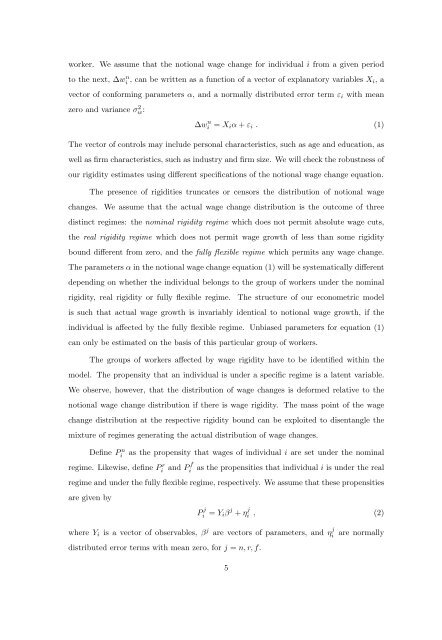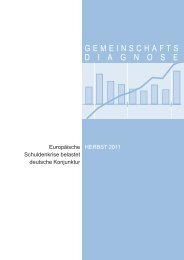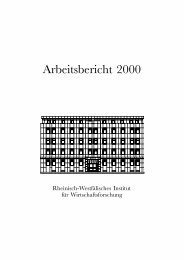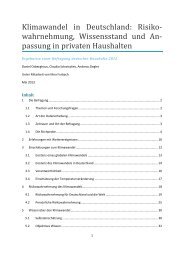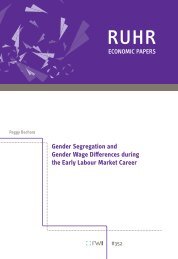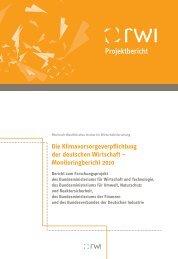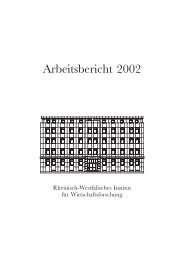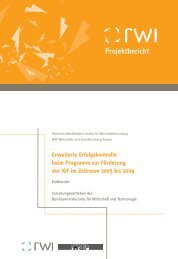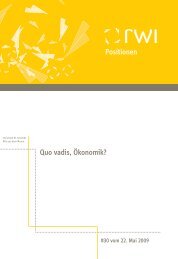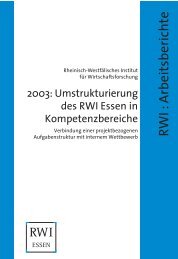RW I:Discussion Papers - Rheinisch-Westfälisches Institut für ...
RW I:Discussion Papers - Rheinisch-Westfälisches Institut für ...
RW I:Discussion Papers - Rheinisch-Westfälisches Institut für ...
You also want an ePaper? Increase the reach of your titles
YUMPU automatically turns print PDFs into web optimized ePapers that Google loves.
worker. We assume that the notional wage change for individual i from a given period<br />
to the next, ∆wi n, can be written as a function of a vector of explanatory variables X i,a<br />
vector of conforming parameters α, and a normally distributed error term ε i with mean<br />
zero and variance σw:<br />
2 ∆wi n = X i α + ε i . (1)<br />
The vector of controls may include personal characteristics, such as age and education, as<br />
well as firm characteristics, such as industry and firm size. We will check the robustness of<br />
our rigidity estimates using different specifications of the notional wage change equation.<br />
The presence of rigidities truncates or censors the distribution of notional wage<br />
changes. We assume that the actual wage change distribution is the outcome of three<br />
distinct regimes: the nominal rigidity regime which does not permit absolute wage cuts,<br />
the real rigidity regime which does not permit wage growth of less than some rigidity<br />
bound different from zero, and the fully flexible regime which permits any wage change.<br />
The parameters α in the notional wage change equation (1) will be systematically different<br />
depending on whether the individual belongs to the group of workers under the nominal<br />
rigidity, real rigidity or fully flexible regime. The structure of our econometric model<br />
is such that actual wage growth is invariably identical to notional wage growth, if the<br />
individual is affected by the fully flexible regime. Unbiased parameters for equation (1)<br />
can only be estimated on the basis of this particular group of workers.<br />
The groups of workers affected by wage rigidity have to be identified within the<br />
model. The propensity that an individual is under a specific regime is a latent variable.<br />
We observe, however, that the distribution of wage changes is deformed relative to the<br />
notional wage change distribution if there is wage rigidity. The mass point of the wage<br />
change distribution at the respective rigidity bound can be exploited to disentangle the<br />
mixture of regimes generating the actual distribution of wage changes.<br />
Define Pi<br />
n as the propensity that wages of individual i are set under the nominal<br />
regime. Likewise, define Pi<br />
r and P f<br />
i<br />
as the propensities that individual i is under the real<br />
regime and under the fully flexible regime, respectively. We assume that these propensities<br />
are given by<br />
P j<br />
i<br />
= Y i β j + η j i , (2)<br />
where Y i is a vector of observables, β j are vectors of parameters, and η j i<br />
distributed error terms with mean zero, for j = n, r, f.<br />
are normally<br />
5


